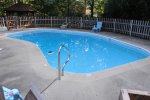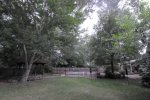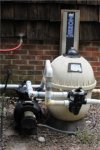Introducing myself -- an old newbie.
Bought a house 2 years ago with an inground pool. Never owned or managed a pool before.
First year, first opening, what a mess, too many trees near the uncovered pool. lots of vacuuming, scooping, bleach, backwashing, etc. Finally got into a routine, about 4 gallons a week.
Then got the Del Ozonator, then the FloatTron, down to one gallon a week.
Installed a new timer for the pump so that it didn't run 24/7, and had a leak (pool light) fixed.
Next a pool cover.
Pump motor failed in November. Decided to get new pump, not simply replace the motor (Enter the Northstar)
Last year, late opening by the pool guy. Lots better, Used only about 5 or 6 gal of bleach all season.
Repaired the Aquabot multiple times, decided I needed a new one this year.
This year, uncovered the pool myself, wanted to be totally "chemical" free. Guess that's not going to happen.
PUt one gallon of bleach down the skimmer, water turned blue but did not clear.
Finally got the new Aquabot Turbo - T2 because the old Turbo really did die this time -- housing broke.
Still no clarity. So, back to the Internet, found this place, like this place, joined this place.
So, Sand? ZeoLite? DE? Cartridge? Activated Charcoal? Hmmm.
Not sure if I will replace the S-200, but I am definitely going to replace at least its sand with new.
Today I bought some DE from Lowe's, added a cup to the skimmer, +1 psi !, in a few hours +5 psi ! going to leave it through tomorrow before I backwash again.
After much consideration, I like the idea of sand+DE that I found here, in this place. Makes a lot of sense. Seems to be a good compromise for ease of maintenance+cost.
Only, the water is very old, essentially, and I'm afraid to drain and refresh from scratch as the water table in my yard is high, there's lots of clay, poor drainage, no drought this year. I'm afraid the concrete bottom half will float up enough to break the plastic plumbing. I have no clue as to how they were able to successfully get the pool in in the first place.
So, what I would like to do is run the water through an Activated Charcoal filter for a while to truly clean the water, and then rebalance the mineral content. I think It's a bit saturated with sodium, because I can't seem to get a build up of copper from the ionizer, and it has been more than one complete season now. I was thinking of getting a DE filter, and using the AC in it first, then replace with DE. Not going to do that now. DE in sand is better idea, and I'm not going to drop > $300 for a one time use.
Why no chlorine? I used to swim competitively, and hate the idea of swimming in toxic stuff = cholorine. Of course, copper is somewhat toxic itself. So, I may end up having to use some chlorine, at least at the opening. Then again, maybe the ionizer is broken (my luck).
I have an AquaChem 6-way "Professional" test kit (from -- oh no -- Walmart), but the manual has been lost.
The alkalinity test is 3 chemicals, by the way.
pH seems to be about 7.2 to 7.6, its hard for me to tell.
Hardness, I added 5 drops for the color to change to blue
Alkalinity, I added 4 drops for the color to clear.
I hope that was correct.
CYA? Stablizer test tube is broken and ....
So, that's where I'm at.
Any clues on how to test Sodium levels?
Any ideas on where I could get the water tested in a mass spectrometer? (geek/nerd that I am).
Oh, I love the NorthStar -- very quiet, great basket.
I like the idea of swimming in oxygenated water.
Want to minimize chemistry as much as possible.
The Turbo-T2 works very well, it actually does free itself from the stairs. Only thing is that sometimes it gulps and traps air and stays running around the surface, only twice so far.
FloatTron? jury is still out. Can't really tell. I think it may have gotten broken somehow last year.
OK, I think that's more than enough said so far.
Bought a house 2 years ago with an inground pool. Never owned or managed a pool before.
First year, first opening, what a mess, too many trees near the uncovered pool. lots of vacuuming, scooping, bleach, backwashing, etc. Finally got into a routine, about 4 gallons a week.
Then got the Del Ozonator, then the FloatTron, down to one gallon a week.
Installed a new timer for the pump so that it didn't run 24/7, and had a leak (pool light) fixed.
Next a pool cover.
Pump motor failed in November. Decided to get new pump, not simply replace the motor (Enter the Northstar)
Last year, late opening by the pool guy. Lots better, Used only about 5 or 6 gal of bleach all season.
Repaired the Aquabot multiple times, decided I needed a new one this year.
This year, uncovered the pool myself, wanted to be totally "chemical" free. Guess that's not going to happen.
PUt one gallon of bleach down the skimmer, water turned blue but did not clear.
Finally got the new Aquabot Turbo - T2 because the old Turbo really did die this time -- housing broke.
Still no clarity. So, back to the Internet, found this place, like this place, joined this place.
So, Sand? ZeoLite? DE? Cartridge? Activated Charcoal? Hmmm.
Not sure if I will replace the S-200, but I am definitely going to replace at least its sand with new.
Today I bought some DE from Lowe's, added a cup to the skimmer, +1 psi !, in a few hours +5 psi ! going to leave it through tomorrow before I backwash again.
After much consideration, I like the idea of sand+DE that I found here, in this place. Makes a lot of sense. Seems to be a good compromise for ease of maintenance+cost.
Only, the water is very old, essentially, and I'm afraid to drain and refresh from scratch as the water table in my yard is high, there's lots of clay, poor drainage, no drought this year. I'm afraid the concrete bottom half will float up enough to break the plastic plumbing. I have no clue as to how they were able to successfully get the pool in in the first place.
So, what I would like to do is run the water through an Activated Charcoal filter for a while to truly clean the water, and then rebalance the mineral content. I think It's a bit saturated with sodium, because I can't seem to get a build up of copper from the ionizer, and it has been more than one complete season now. I was thinking of getting a DE filter, and using the AC in it first, then replace with DE. Not going to do that now. DE in sand is better idea, and I'm not going to drop > $300 for a one time use.
Why no chlorine? I used to swim competitively, and hate the idea of swimming in toxic stuff = cholorine. Of course, copper is somewhat toxic itself. So, I may end up having to use some chlorine, at least at the opening. Then again, maybe the ionizer is broken (my luck).
I have an AquaChem 6-way "Professional" test kit (from -- oh no -- Walmart), but the manual has been lost.
The alkalinity test is 3 chemicals, by the way.
pH seems to be about 7.2 to 7.6, its hard for me to tell.
Hardness, I added 5 drops for the color to change to blue
Alkalinity, I added 4 drops for the color to clear.
I hope that was correct.
CYA? Stablizer test tube is broken and ....
So, that's where I'm at.
Any clues on how to test Sodium levels?
Any ideas on where I could get the water tested in a mass spectrometer? (geek/nerd that I am).
Oh, I love the NorthStar -- very quiet, great basket.
I like the idea of swimming in oxygenated water.
Want to minimize chemistry as much as possible.
The Turbo-T2 works very well, it actually does free itself from the stairs. Only thing is that sometimes it gulps and traps air and stays running around the surface, only twice so far.
FloatTron? jury is still out. Can't really tell. I think it may have gotten broken somehow last year.
OK, I think that's more than enough said so far.







